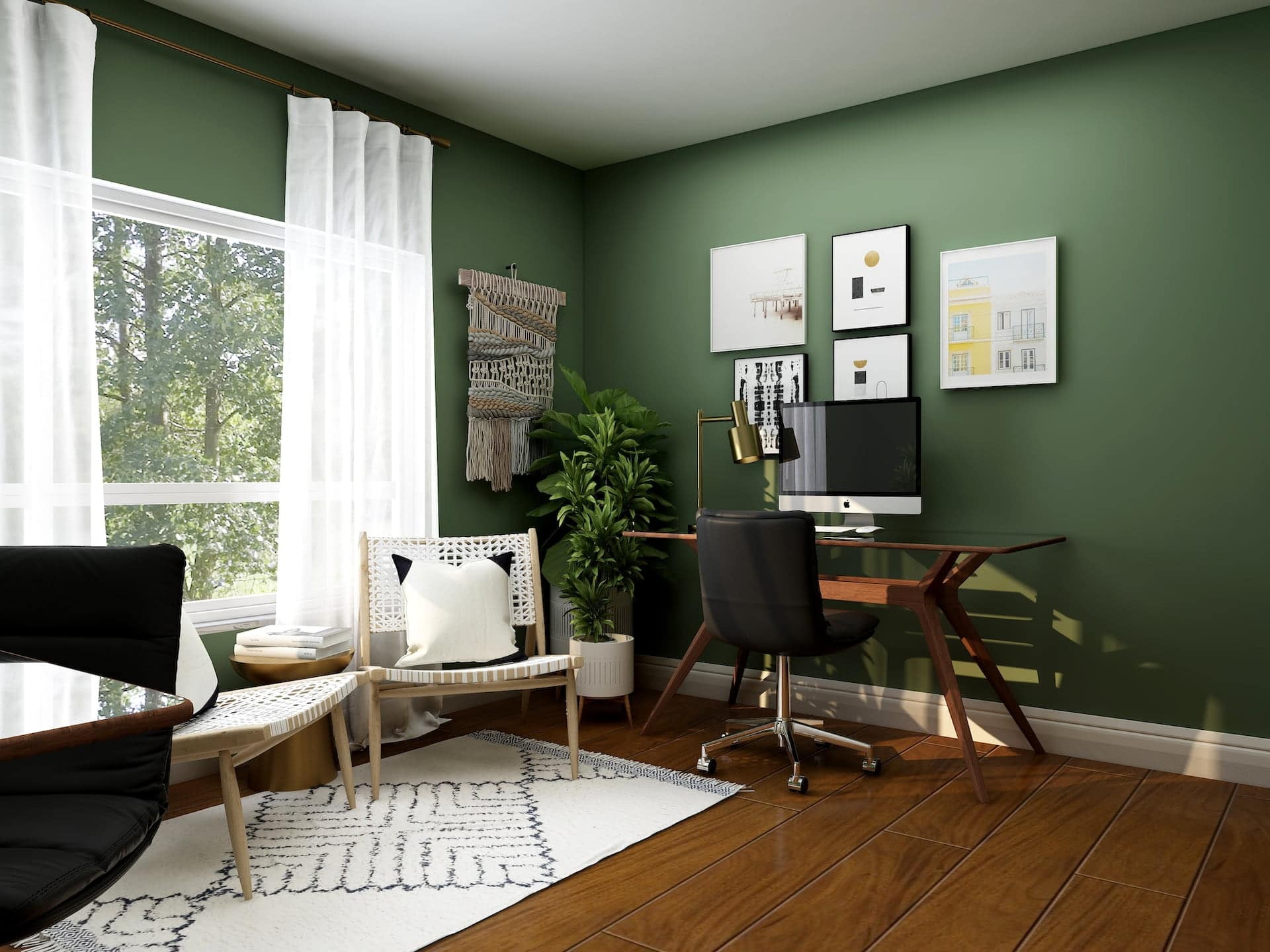With remote work becoming increasingly popular, having a home office has become crucial to our daily lives. If that resonates with you, designing a workspace that both enhances productivity and reflects your unique personality is essential.
This eXp Realty guide will discuss several creative and practical home office ideas that impress your coworkers on your next Zoom call.
Choose the Perfect Location for Your Home Office
Choosing the perfect location for your home office is a key step. Assessing your home’s available square footage and natural lighting is crucial to create a workspace that fuels productivity and fosters creativity.
You may have an extra bedroom or guest bedroom that could double as a dedicated home office space. Alternatively, a quiet corner in your master bedroom, a portion of a spacious living room, or even a previously underutilized area, like under the stairs, could be transformed into an office workspace.
In urban areas where space is often at a premium, such as in San Francisco, residents have been known to repurpose furniture creatively. A kitchen table or dining table can turn into an office desk during the day, and with a few tweaks, a dressing table could also serve as a practical desk space.
The Value of a Dedicated Workspace
It’s important to create a separate and dedicated workspace. This area helps maintain a work-life balance by separating your professional workstation from your personal life.
This can be as simple as setting up your office supplies on one end of a table that you use only during work hours, creating an entire space within an extra bedroom or guest room, or even establishing a backyard home office for a serene and natural environment.
Remember, your workspace should cater to your specific needs, your work habits, and, of course, your style. Whether you want a modern update to your workspace or prefer an office design adorned with antique pieces, the decision is yours. Just make sure you’re creating a space that you’re comfortable in and reflects who you are.
For those needing more extensive office setups, such as a spacious home office in an extra room or converting part of a garage or outbuilding into a garden office, you may need to seek planning permission. If you need more clarification, consult your local planning office or an architect to help navigate the process.
Furniture and Layout Ideas
The right furniture and layout can greatly improve your efficiency and comfort. It all starts with your office desk and chair.
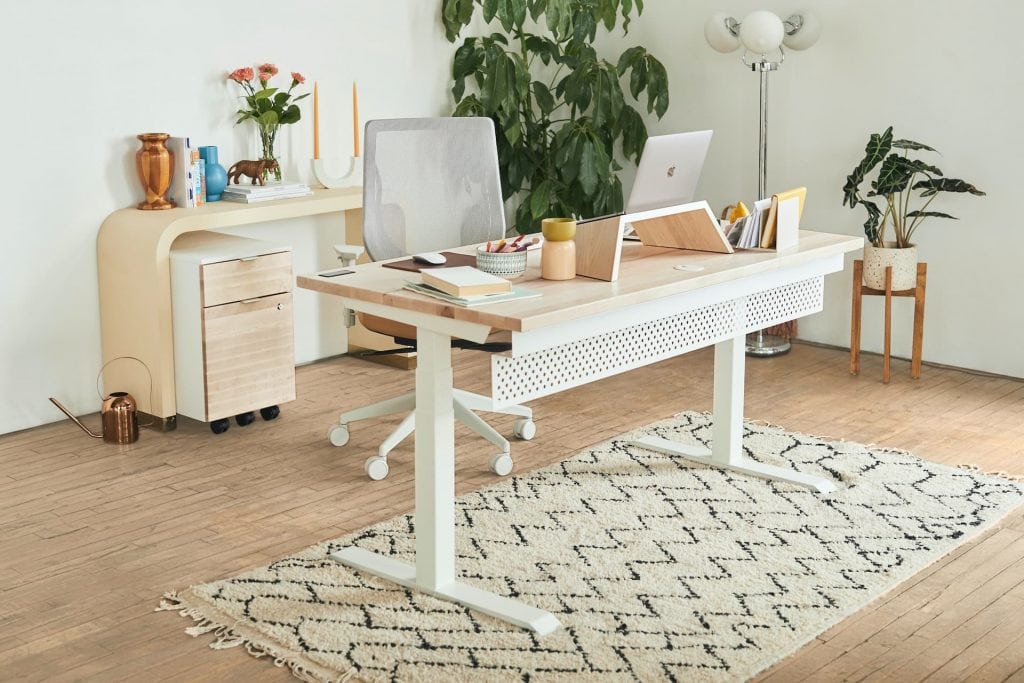
Invest in an ergonomic desk chair that provides support and promotes good posture. A comfortable chair reduces strain and enhances your productivity throughout the day. Whether you fancy a plush, supportive desk chair or a sleek, modern-style chair, there’s an option to fit every preference and décor.
The Desk
Depending on the space available, you could opt for a modern, L-shaped, or built-in desk. If you’re tight on space, consider a white desk that blends in with white walls to create a seamless, airy look. Or, if you’re after a statement piece, opt for a desk with built-in USB ports or an eggshell home-style desk for a luxurious vibe.
The surface should be spacious enough to accommodate your computer, office supplies, and coffee for those long workdays.
Storage Ideas
In a small home office, vertical space often needs to be more utilized. Make the most of this space by installing floating shelves or a bookcase to store your coffee table books, documents, and other office essentials.
Vertical storage maximizes space and adds visual height to the room, making it appear larger. For larger items, consider closed storage solutions such as cabinets or storage boxes that can easily slide under the desk.
Organization & Personalization
To maintain an organized and clutter-free workspace, Marie Kondo your office by keeping only items that spark joy or are necessary for your work. A clean workspace can help keep your mind clear and focused on the tasks.
For a personal touch, incorporate decorative accents that reflect your style. This could be a favorite piece of art, a collection of your favorite home office décor, or even pops of color from accessories or furniture that bring the room to life. If you’re a fan of a neutral color palette, add a pop of color with a comfy chair and desk or floor lamps.
If your home office is part of an open-plan living area, use room dividers or screens to separate your office space. This can create a sense of privacy and help you stay focused. You can also use area rugs to define your workspace, adding a cozy touch to the room.
Lighting and Color Palette
Lighting and color create an inviting, stimulating, and productive work environment. They are essential to consider when planning your home office setup and design.
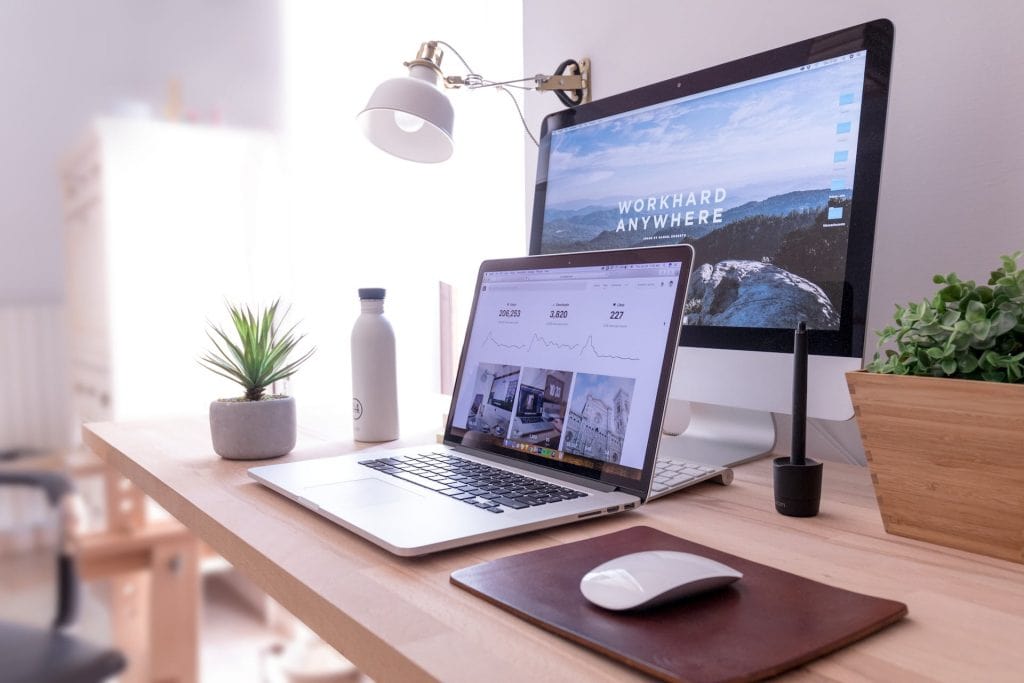
Natural & Artificial Lighting
Firstly, maximize the amount of natural light in your office workspace. Place your desk close to the windows if possible. Natural light can boost mood and energy, helping to reduce eye strain and increase efficiency. If you’re blessed with a panoramic view, it’s even better. The scenery can be a perfect focal point and provide much-needed mental breaks during your workday.
For those times when natural light is limited or for working in the evening hours, you’ll need adjustable quality artificial light. Task lighting, such as a desk lamp, is vital for focused work. Additionally, consider adding floor lamps or some kind of scone light to ensure your space is well-lit.
As for window treatments, install curtains or blinds. They control the amount of daylight entering your office and add a touch of style and texture to your space. Choose lighter fabric curtains for a soft, diffused light, or go for blinds if you prefer a sleek, modern look to your area.
The Colors
When choosing a color palette for your home office, consider what colors make you feel good and help you work best. Research has shown that colors can significantly impact our mood and productivity. For instance, blue stimulates the mind, yellow sparks creativity, red impacts the body, while green fosters a calming balance.
Neutral colors like white, beige, or gray walls provide a serene and sophisticated backdrop that pairs well with any office furniture or accent color. For a more vibrant look, you can paint one wall in your favorite color or add pops of color through accessories and furniture. The options are endless, from the classic white desk to a bold, dark wall color.
Personalize Your Space
One of the major advantages of a home office is the freedom to design and personalize your space in a way that reflects your personality and resonates with your interests. It’s about crafting an environment where you feel inspired, focused, and comfortable, from the color scheme to the choice of office supplies.
Make the Space Your Own
Begin by adding pieces that make your workspace feel uniquely yours. This could be a favorite piece of art, a collection of coffee table books, or even personal mementos like photos or travel souvenirs. Displaying items that have personal meaning can make your workspace feel comforting and stimulating.
The Green Touch
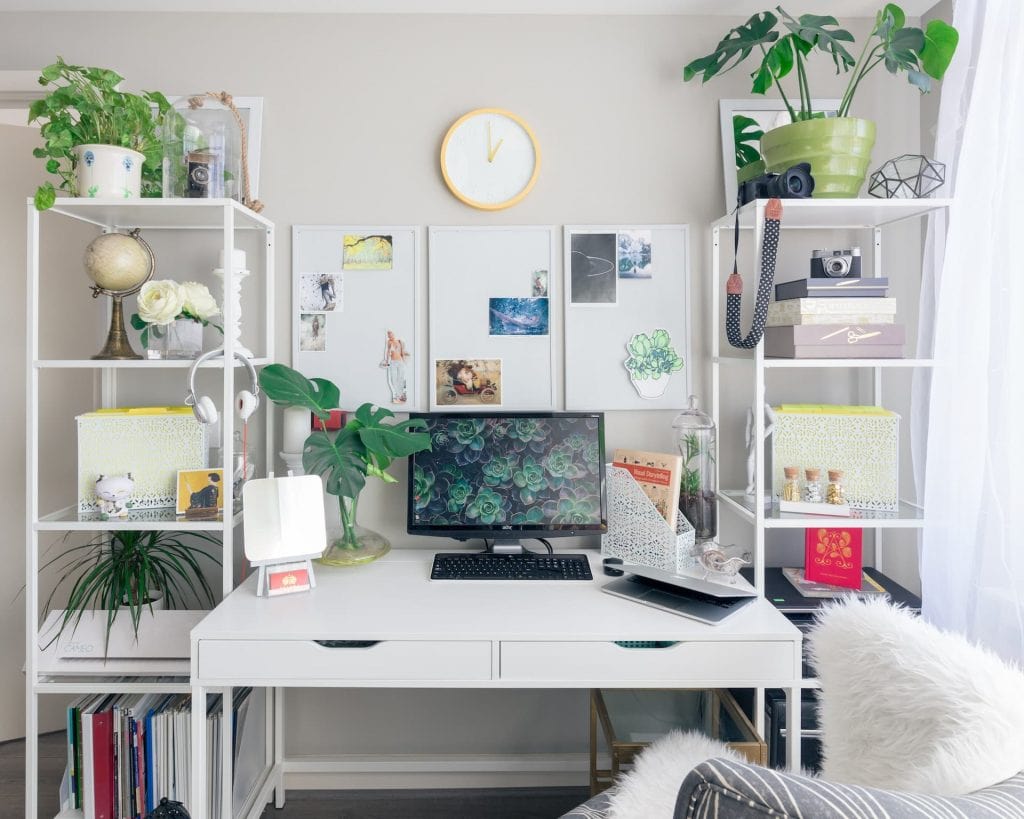
Next, consider adding some greenery to your space. Indoor plants add a refreshing touch of nature to your workspace and have health benefits such as improving air quality and reducing stress levels. Artificial plants can provide a similar aesthetic without maintenance if you don’t have much of a green thumb.
Furniture that Reflect your Taste
For a truly personal touch, consider showcasing your style through furniture choices. Do you lean towards a modern style with clean lines and minimalist designs, or do you like vintage or antique pieces? Each piece of furniture can reflect your taste and style, from the modern desk to the comfortable chair.
Think of the Backdrop
Also, remember your workspace’s visual aspect, especially if you frequently have video calls or virtual meetings. Think about creating a stylish backdrop that will dazzle your coworkers on Zoom. This could be a neatly organized bookshelf, a gallery wall of inspiring artwork, or even a striking accent wall.
Pops of Color
Moreover, if you want to have some fun with your space, consider adding a pop of color to liven up the area. This can be achieved through colorful office supplies, a vibrant desk, or a funky desk lamp. Don’t be afraid to experiment with bold colors and patterns, as they can inject energy and stimulate creativity.
Don’t Underestimate Comfort
Lastly, remember the importance of comfort in your workspace. Invest in a supportive or comfy desk chair, add a cozy rug underfoot, or consider a standing desk for flexibility. Remember, you’ll be spending significant time in this space, so making it as comfortable as possible is essential.
Acoustic Treatment and Noise Reduction
Managing noise and distraction is crucial for maintaining productivity and focus, especially during virtual meetings. Install sound-absorbing panels or acoustic foam to control noise levels effectively. These products are designed to minimize echo and reduce background noise, which can be particularly beneficial if your workspace is in a large or open area with hard surfaces.
Various types of sound-absorbing panels are available, ranging from fabric-wrapped panels to foam-based options. Choose materials and designs that suit your home office’s aesthetics and offer the best acoustic performance.
If you prefer a budget-friendly approach, consider creating DIY sound-absorbing panels using materials like thick curtains, canvas frames filled with insulation, or repurposed materials.
Layout and Acoustics
The layout of your room and the placement of your furniture can also significantly impact the acoustics. If your desk is currently positioned near a noisy kitchen or next to a bustling street window, consider moving it to a quieter part of the room or even a different one altogether.
If you have bookshelves, cabinets, or other furniture items, strategically arrange them to act as natural barriers to sound. These items can help diffuse sound waves and reduce the impact of noise coming from different directions.
Rugs and Carpets
Additionally, you can place area rugs or carpets in your home office to help absorb some of the sounds and create a more acoustically friendly environment.
Beyond physical adjustments to your workspace, there are also technological solutions available. For instance, noise-canceling headphones can be invaluable for blocking background noise and enabling you to focus on your work. Similarly, apps that generate white noise or relaxing sounds can help mask distracting noises and create a soothing work environment.
Practical Storage and Organization
Practical storage solutions and organizational tools can help you keep your workspace clutter-free and your work process streamlined, thus, improving overall productivity.
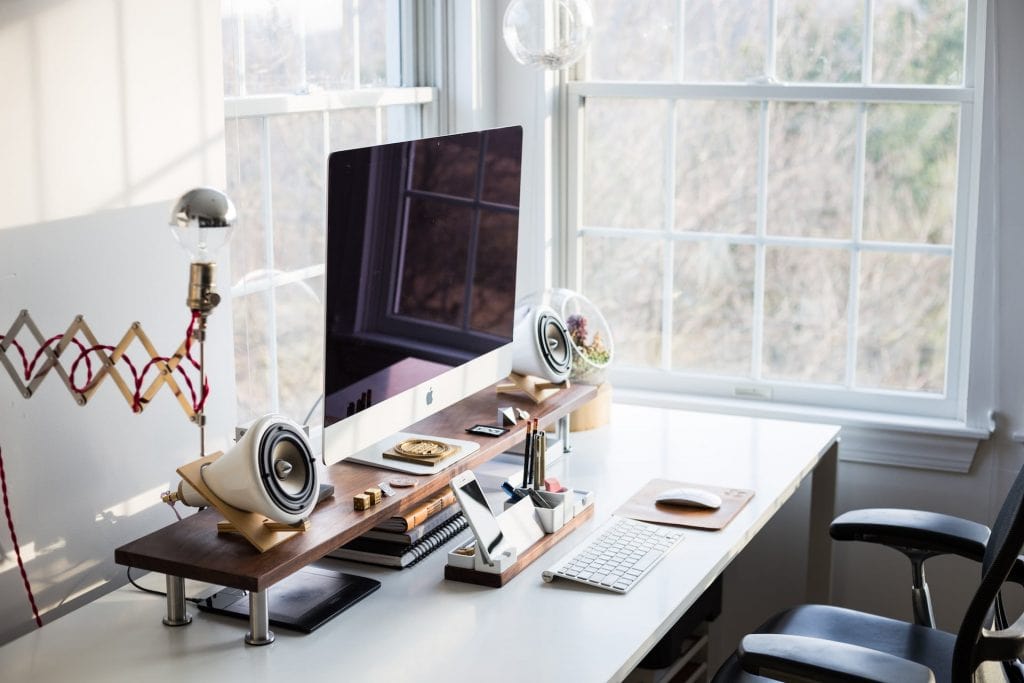
One approach to improving your office organization is to use desk organizers like pen holders, letter trays, and desktop drawers to keep frequently used items within easy reach. These compact tools are great for keeping your office supplies within easy reach and in order.
Meanwhile, file cabinets and storage boxes can house your essential documents, tools, and other work-related items. Choose adequate, labeled boxes to store things like old paperwork, seasonal decorations, or rarely used office supplies, keeping them out of sight until necessary.
Go Paperless!
Additionally, consider going paperless to reduce clutter and streamline your workflow. Invest in a reliable scanner or use smartphone apps that can scan documents. Digitize necessary paperwork and save them in organized folders on your computer or cloud storage platforms. This overall approach not only saves space but is also eco-friendly.
Use cloud storage services like Google Drive, Dropbox, or OneDrive to store your digital documents securely. Cloud built-in storage ensures accessibility from anywhere and serves as a backup solution.
Categories and Labels
To keep everything in its place, develop a system for labeling and categorizing items. Invest in a label maker or use printable labels to tag your storage boxes, file folders, and other containers. You should also organize things based on how frequently you use them.
Extend the labeling system to your digital documents. Create a logical folder structure with clear names, making it easy to find specific files quickly.
Green and Sustainable Office Solutions
Incorporating green and sustainable solutions in your home office benefits the environment and contributes to a healthier and more inspiring workspace.
Reduce your carbon footprint and lower energy consumption by choosing eco-friendly and energy-efficient office equipment. Consider investing in Energy Star-certified appliances or office supplies made from recycled materials.
Additionally, use smart power strips that automatically power down peripheral devices when your computer sleeps or shuts down. This prevents “phantom power” consumption and helps reduce energy waste.
Furniture, Decor and Plants
Furniture and decor can also be sourced sustainably. Get creative with upcycling by repurposing old items into decorative elements. For example, turn old glass jars into pen holders or use reclaimed wood to create a bulletin board or wall art.
Additionally, consider purchasing second-hand furniture from thrift stores, online marketplaces, or garage sales instead of new pieces.
Adding plants into your space is another way to create a greener office. They can improve air quality, increase your sense of well-being, and even boost productivity. Incorporate biophilic design principles by placing plants strategically around your home office. Greenery near your desk or within your sight can reduce stress and increase productivity.
Furthermore, choose indoor plants known for their air-purifying properties, such as spider plants, peace lilies, or snake plants. These plants help filter toxins from the air, creating a healthier indoor environment.
Lastly, remember that even small changes can make a big difference. Turning off equipment when not in use, reducing paper waste, and recycling can all contribute to a greener office. In doing so, you’ll not only have a workspace that’s good for you but also the planet.
Key Takeaways
In this modern era of remote work, having a well-designed home office has become more critical than ever. A visually appealing workspace can enhance productivity and leave a lasting impression on your coworkers during virtual meetings.
Choosing the perfect location for your home office is the first step in creating a conducive working environment. When it comes to furniture and layout, prioritize ergonomics and comfort. Invest in a comfortable chair and a spacious home office desk that suits your workflow.
Furthermore, maximize natural light, add appropriate task lighting, and choose a color scheme that stimulates productivity and mirrors your style. Personalize your space with pops of your favorite color, pieces of art, or a backdrop that reflects your personality.
Finally, consider integrating green and sustainable office solutions, like energy-efficient office equipment and indoor plants, to foster a healthy and eco-friendly workspace.
Remember, the goal is not just to create a workspace but to design a home office that will wow your colleagues and inspire you to be your most productive self.
Ready to transform your workspace or need a new property with more office space? Search for properties on eXp Realty or contact a local eXp agent for expert advice. You can also sign up for alerts of new property listings as they come on the market, ensuring you never miss out on your dream home.
FAQs: Home Office Ideas
If you are considering creating or upgrading your home office, you may have questions about the process and the benefits. Here are some common questions and answers to help you get started.
How much value does an office add to a home?
The exact amount of value of having a home office varies widely depending on the location, size, and overall real estate market. Generally, a well-designed and functional office can be an attractive selling point for potential buyers and may increase the home’s overall value.
What should be included in a home office?
A functional home office should include a comfortable desk and chair, good lighting, storage solutions, sound-proofing equipment, and tech essentials like a reliable computer and high-speed internet. It’s also helpful to have items that aid productivity, such as calendars, bulletin boards, and a dedicated space for files and supplies.
How can I make my home office better?
Enhancing your home office can be as simple as improving the lighting, organizing your workspace, and adding personal touches like plants or artwork. Remember to regularly declutter your desk and use storage solutions like shelves, filing cabinets, and desk organizers to keep everything tidy.
How do I set up an inexpensive home office?
Setting up an inexpensive home office can be accomplished by repurposing existing furniture, shopping for second-hand items, and doing a DIY setup. Prioritize essentials like a desk, chair, and good lighting. Utilize storage solutions like shelves and boxes to organize your workspace efficiently.
Should I put a TV in my home office?
Whether to include a TV in your home office depends on your work habits. If having a TV won’t distract you, it can serve as a secondary monitor or provide background noise. However, if it’s likely to disrupt your productivity, it might be best to avoid it.
Should a desk face a window?
Facing a desk toward a window can provide natural light and a pleasant view, which can be beneficial for mood and productivity. However, it’s important to consider factors like glare on your computer screen or potential distractions.
Should my desk face the door?
According to the principles of Feng Shui, facing your desk towards the door can enable you to see opportunities coming your way. Moreover, it can be beneficial psychologically, as it allows you to see who’s entering your workspace, offering a sense of control and security.
However, if you get easily startled upon seeing others enter your space, it might be best to face away from the door or not directly in its line of sight.
How to make a home office in a living room?
A home office can be created in a living room by designating a specific area for work. Use room dividers, shelves, or rugs to differentiate the space. Choose compact and dual-purpose furniture to make the most of the space.
What not to have in a home office?
Your home office should be free from distractions, so avoid unnecessary electronics or clutter. Personal items unrelated to work, like laundry or dishes, should be kept out of the workspace to maintain a professional environment.
Should your home office be in your bedroom?
Keep your home office out of your bedroom to separate work and rest. However, if space is limited, a bedroom office can work if you clearly differentiate the workspace from the sleeping area using room dividers or separate lighting.
